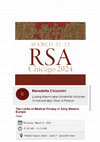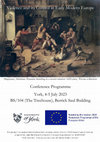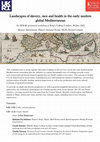Conference Presentations by Benedetta Chizzolini

Early modern galley crews consisted of three types of rowers: free rowers, the so-called buonavog... more Early modern galley crews consisted of three types of rowers: free rowers, the so-called buonavoglia; convicts, i.e., forzati or galeotti; and slaves, generally referred to as “Turks”. The purpose of this paper is to reflect on the status of these three categories of rowers, their differences, and similarities. These were, in fact, very ambiguous conditions whose boundaries were extremely blurred. This was particularly true with regard to convicts and slaves. Both, indeed, experienced a deprivation of their liberty, which could be permanent or temporary; they were subject to the same duties, food, and accommodation; and even their clothing differed only in the slightest detail. Indeed, deprivation of liberty could take three forms: slavery/servitude, under the rule of a master; isolation and imprisonment, by order of the law; imprisonment, under a political and/or religious enemy.
What I would like to suggest with this paper is that belonging to a different geographical and/or religious context merely contributed to an already existing status of marginality by the mere fact of being employed as a (forced) rower on a galley. My ultimate aim is to contribute to a reflection on the deeper meaning of “slavery” and “deprivation of liberty”, as well as on the supposedly neat distinction between “free” and “unfree” (labour). With this aim, documents relating to the papal galleys of Civitavecchia and the Tuscan galleys of Livorno will be analyzed.

Historical research “from above” takes into account any kind of source produced by the political ... more Historical research “from above” takes into account any kind of source produced by the political power at the institutional level, be it manuscript or printed. Although it is a type of research that mainly takes place in archives ,most sources are printed rather than manuscript.
This is particularly true when it comes to analyzing orders issued in the form of proclamations or edicts. As they were addressed to the entire population, the text was written in the vernacular, printed in clearly visible characters, and posted in the most frequented places of the city, usually market squares, churches, inns, hotels, and on the city gates. The ritual of posting required a public reading of the edict, so that everyone, even those who could not read, would be made aware of the provisions. Generally, these sources are collected in special envelopes because of their recognized value for historical research.
A particularly rich period for the promulgation of edicts was undoubtedly the plague epidemics, which at the time required constant revision and provision of new and more careful rules to regulate the population with the aim of containing contagion. Central to this objective were decrees to control and regulate the movement of people and goods through the provision of the health certificate system. These were paper documents certifying a person's health and had to be presented to the officers guarding the city gates. The text of the document was printed on a single page, in Italian, and in clearly visible characters, with spaces for the recipient's personal details to be filled in by hand. As these documents were usually returned to the beneficiary, few copies have survived in the archives. When they do, they are usually found among the court documents, as material evidence in the event of forgery.

The need for disciplined and God-fearing soldiers in the conflicts against heretics made an exten... more The need for disciplined and God-fearing soldiers in the conflicts against heretics made an extensive program of catechization of the armies imperative. The ideal of the miles christianus could have only been realized through a strict system of controlling the behavior of soldiers employed in both land and sea armies. In the fleets, the use of convicts and slaves to complete the crew made it necessary to tighten control over acts and behaviors that were considered criminal and immoral. In this sense, the Battle of Lepanto was a turning point, marking the beginning of a stable and massive presence of religious on board galleys. In 1571, 29 Capuchins embarked on board the papal galleys, and with the papal brief Cum dilectus filius, promulgated in March of the same year, they were granted full faculties to celebrate the sacraments on board the galleys.
Reading the sources, it seems possible to find evidence of the imposition of the Counter-
Reformation scheme even on board galleys, with the aim of transforming soldiers and forced rowers into members of the ideal Catholic army. In this sense, the galleys could be defined as a kind of Otras Indias: barbaric, uncivilized, and superstitious spaces that required a mission of evangelization and initiation into the values of Christian morality to be carried out by religious orders, for which the Capuchins, and then the Jesuits, claimed responsibility. Aboard the galleys we thus find the presence of missionaries in the proper sense of the term. After all, galley rowers were enslaved and condemned rowers, and therefore blasphemous, criminal, and immoral people. This hypothesis is confirmed by the archival sources and, in particular, by the reports and instructions of the Jesuits on the so-called “missions” carried out on the galleys of Civitavecchia in the 18th century, with the express purpose of confessing and catechizing the rowers of the galleys and
comforting the sick rowers in the hospital.
It is possible to find the same scheme in the Tuscan context. Even if the Livorno sources
mention fewer official missions than those of Civitavecchia, the life of the galley rowers in the Bagno can be considered a mission itself, carried out every day since the Capuchins took command in 1677. Their leader himself, Father Ginepro, was a former missionary in the very rural areas of Bologna, and was appointed "chief missionary of the Bagno and the galleys of Livorno".

Respect for patient privacy and confidentiality is an ancient and a contemporary professional res... more Respect for patient privacy and confidentiality is an ancient and a contemporary professional responsibility of physicians. Already the Hipporatic Oath provided for the obligation of confidentiality between doctor and patient with these words : “What I may see or hear in the course of the treatment or even outside of the treatment in regard to the life of men, which on no account one must spread abroad, I will keep to myself, holding such things shameful to be spoken about”. The diagnostic examination thus took the form of a kind of confession by the patient to the doctor, who, like the priest, was not supposed to betray the patient’s trusty and reveal to third parties what he had discovered during the medical examination.
Although several authors compared the breaking of the confidentiality Oath to a real mortal sin, Paolo Zacchia, in his Quaestiones Medico-Legales (1621-1635), did not hesitate to point out that, in reality, there were certain situations in which this rule could not (indeed, should not) be respected. Thus, although both doctors and patients were considered to have a moral obligation to always tell the truth, there were a limited number of circumstances in which the doctor was exempt from this obligation. The “professional secrecy” stated in the Hippocratic Oath completely lost its value when doctors acted in an “institutional” position, such as when they were called as a peritus to give their opinion in judicial proceedings. The centrality of professional confidentiality is demonstrated by the fact that Zacchia concerns himself with the topic three times, in Books III, V, and XII. In particular, Zacchia recalls how the real mortal sin for doctors was to give false testimony about the symptoms and illness of the patient/defendant when they were called as experts or witnesses in court.
This ambiguity in the doctor-patient relationship was also expressed to the greatest extent in the duty to report to which medical personnel were subject in the early modern period. If, as we have seen, the medical examination revealed signs of the patient’s involvement in activities considered illegal and/or immoral (often two sides of the same coin), the doctor was legally obliged to break professional confidentiality and report the patient to the political authorities. Thus, although the primary goal of medical activity has always been to ensure the patient’s good health, the doctor’s loyalty seemed to lie primarily with those exercising political power rather than with the patient.
Seminario OFFISS- Bologna, 24 ottobre 2023
„Kulturelle und wissenschaftliche Beziehungen im Mittelmeerraum von der Antike bis in die Gegenwa... more „Kulturelle und wissenschaftliche Beziehungen im Mittelmeerraum von der Antike bis in die Gegenwart„- International Workshop, Padova, September 29-30, 2023

As Cesare Santus has wrote in his book Il turco a Livorno, violence in Livorno was very
spread, ... more As Cesare Santus has wrote in his book Il turco a Livorno, violence in Livorno was very
spread, as in every sea port full of desperate men in search of luck, soldiers accustomed to violence, mariners and taverns. Violence was the order of the day not only in the city’s streets, but also in the same Bagno which Santus describes as a violent microcosm, with its own rules and codes of behavior typical of prison institutions and servile conditions.
As has already been pointed out by Lucia Frattarelli Fischer the government of the Bagno was based on a militaristic discipline and the structural use of institutionalized violence and bodily punishment. As stated in the regulations of the Bagno, the maintenance of order was entrusted to the guardians, who responded to the orders of the aguzzini
and the captain of the Bagno. The Bagno, states the instruction, had to be similar to a fortress and its guardians had to be particularly vigilant as in this particular case the enemy was inside and not outside and were individuals of the worst kind, and continuously tried to escape. 9he strict control system and severe corporal punishment did not prevent the occurrence of disorders and violence, which, according to the sources, were indeed the order of the day.

From a medical point of view, the status of slave and convict in the galleys was almost equal, si... more From a medical point of view, the status of slave and convict in the galleys was almost equal, since the doctor's duties were the same for both categories. The latter had to be treated with all possible zeal and charity, for navigation was impossible without a healthy and strong crew. However, as they were primarily forced rowers on the galleys, doctors had to be constantly on the alert for them and treat them with extreme caution, if not outright suspicion. Differences in treatment, where they existed, were based on religious rather than medical motivations. This paper is therefore also an opportunity to reflect on the ambiguous and complicated relationship between medicine and religion in the early modern period. In the early modern period, physical and spiritual care were closely linked and intertwined, and thus the collaboration of lay and religious personnel in hospitals was inevitable. Since their institution in late antiquity and the early Middle Ages as places of refuge for travellers and pilgrims, hospitals were first and foremost places of religious piety. Indeed, caring for the sick was perfectly consistent with the evangelical imperative to care for those in need. Within hospitals, the alternating cooperation, competition and conflict between medicine and religion is evident both in the overlap between physical and spiritual care, and in the coexistence of lay and clerical health and administrative staff. The care of the body and the care of the soul were seen as two sides of the same coin, even if usually the latter seemed to take precedence over the former. If the early modern period represents a moment of progressive secularisation of the medical profession, its independence from religion was still a long way off. Indeed, it is sufficient to consider how certain areas of life were still completely excluded from the doctor's domain, as is evident from the doctor's obligation to leave space to the priest in the event of a prognosis of certain or even presumed death, so that the patient could receive the Extreme Unction. After all, illness was a divine punishment, and nothing could cure the body unless the spirit was first healed. Spiritual care in hospitals became even more urgent when it came to hospitals dedicated to the care of slaves and convicts, who were considered highly immoral and not infrequently blasphemous individuals.

Early modern galley crews consisted of three types of rowers: free rowers, the so-called buonavog... more Early modern galley crews consisted of three types of rowers: free rowers, the so-called buonavoglia; convicts, i.e., forzati or galeotti; and slaves, generally referred to as “Turks”. The purpose of this paper is to reflect on the status of these three categories of rowers, their differences, and similarities. These were, in fact, very ambiguous conditions whose boundaries were extremely blurred. This was particularly true with regard to convicts and slaves. Both, indeed, experienced a deprivation of their liberty, which could be permanent or temporary; they were subject to the same duties, food, and accommodation; and even their clothing differed only in the slightest detail. But above all, both categories of rowers were considered “deviant” and “marginal” in the name of their behavior, religion, geographical origin and, to a certain extent, their “nature”. Dressed like the convicts and subjected to the same tasks, the slaves differed from them only in their faith and in the fact that they wore a topknot over their hulls, otherwise completely shaven. Indeed, it should not be forgotten how in the same sources convicts were often referred to as “slaves for punishment” (servi/schiavi di pena). As Giovanna Fiume has already pointed out, the sentence to the galley, albeit with due differences, fell perfectly within the category of “servitude by punishment” as theorized by Roman law. Indeed, deprivation of liberty could take three forms: slavery/servitude, under the rule of a master; isolation and imprisonment, by order of the law; imprisonment, under a political and/or religious enemy. Moreover, also the third category of galley rowers, the buonavoglia, actually had much more in common with the other two categories than just rowing. Insofar as, or perhaps exactly because, they served on the galleys voluntarily, «selling their freedom for a few pennies», they were considered a marginal and suspect category on par with convicts and slaves. It is interesting to note that one of the most severe crimes of whom they could be punished was “desertion”, that is, failure to comply with the time of service stipulated in the contract, which in the majority of cases was punished exactly by a galley sentence. This also raises questions about the supposed freedom of free rowers.
What I would like to suggest with this paper is that belonging to a different geographical and/or religious context merely contributed to an already existing status of marginality by the mere fact of being employed as a (forced) rower on a galley. This is not, of course, to question the assumption that slaves were treated even more hostilely than convicts because of their different religious beliefs and geographical origins. Rather, my ultimate aim is to contribute to a reflection on the deeper meaning of “slavery” and “deprivation of liberty”, as well as on the supposedly neat distinction between “free” and “unfree” (labour). With this aim, documents relating to the papal galleys of Civitavecchia and the Tuscan galleys of Livorno will be analyzed.
Workshop internazionale
Organised by the SFB 1369- Vigilanzkulturen (LMU) and DISSGEA (Universi... more Workshop internazionale
Organised by the SFB 1369- Vigilanzkulturen (LMU) and DISSGEA (Università degli Studi di Padova)
Padua, 12-13 December 2022
“Non con l’autorità ma col far vedere le cose”: Identità e rappresentazioni nel Settecento
Works... more “Non con l’autorità ma col far vedere le cose”: Identità e rappresentazioni nel Settecento
Workshop internazionale
Roma, Istituto Svedese di Studi Classici, 7 dicembre 2022
Health and Work in the Early Modern World, 1500-1750 ca. Venice, 20-21 September 2022
"Il teatro della Turchia- Visioni del Vicino Oriente in età moderna"
Pisa, 12-14 maggio 2022
Atelier doctorale “Sociétés carcérales. Espaces, circulations, connexions”.
Rome, École française... more Atelier doctorale “Sociétés carcérales. Espaces, circulations, connexions”.
Rome, École française de Rome, 25-29 octobre 2021.
Intervento all’interno del convegno “Attraverso la Storia” (Bologna, 7-8 aprile 2022)
Panel “For... more Intervento all’interno del convegno “Attraverso la Storia” (Bologna, 7-8 aprile 2022)
Panel “Forme e spazi del controllo sociale. Pratiche punitive e strategie di vigilanza in epoca moderna”
Seminar in the Kolloquiumsreihe "Neue Forschungen zur Frühen Neuzeit", LMU München, February 14th... more Seminar in the Kolloquiumsreihe "Neue Forschungen zur Frühen Neuzeit", LMU München, February 14th, 2022
Book chapters by Benedetta Chizzolini
Jake Dyble, Alessandro Lo Bartolo, Elia Morelli (a cura di), “Un mare connesso.Europa e mondo islamico nel Mediterraneo (secoli XV-XIX), 2024
Book Chapter, in Jake Dyble, Alessandro Lo Bartolo, Elia Morelli (a cura di), “Un mare connesso. ... more Book Chapter, in Jake Dyble, Alessandro Lo Bartolo, Elia Morelli (a cura di), “Un mare connesso. Europa e mondo islamico nel Mediterraneo (secoli XV-XIX), pp. 71-92.
Articles by Benedetta Chizzolini
Blog post - Medicine and the Making of Race's Blog (King's College London)










Uploads
Conference Presentations by Benedetta Chizzolini
What I would like to suggest with this paper is that belonging to a different geographical and/or religious context merely contributed to an already existing status of marginality by the mere fact of being employed as a (forced) rower on a galley. My ultimate aim is to contribute to a reflection on the deeper meaning of “slavery” and “deprivation of liberty”, as well as on the supposedly neat distinction between “free” and “unfree” (labour). With this aim, documents relating to the papal galleys of Civitavecchia and the Tuscan galleys of Livorno will be analyzed.
This is particularly true when it comes to analyzing orders issued in the form of proclamations or edicts. As they were addressed to the entire population, the text was written in the vernacular, printed in clearly visible characters, and posted in the most frequented places of the city, usually market squares, churches, inns, hotels, and on the city gates. The ritual of posting required a public reading of the edict, so that everyone, even those who could not read, would be made aware of the provisions. Generally, these sources are collected in special envelopes because of their recognized value for historical research.
A particularly rich period for the promulgation of edicts was undoubtedly the plague epidemics, which at the time required constant revision and provision of new and more careful rules to regulate the population with the aim of containing contagion. Central to this objective were decrees to control and regulate the movement of people and goods through the provision of the health certificate system. These were paper documents certifying a person's health and had to be presented to the officers guarding the city gates. The text of the document was printed on a single page, in Italian, and in clearly visible characters, with spaces for the recipient's personal details to be filled in by hand. As these documents were usually returned to the beneficiary, few copies have survived in the archives. When they do, they are usually found among the court documents, as material evidence in the event of forgery.
Reading the sources, it seems possible to find evidence of the imposition of the Counter-
Reformation scheme even on board galleys, with the aim of transforming soldiers and forced rowers into members of the ideal Catholic army. In this sense, the galleys could be defined as a kind of Otras Indias: barbaric, uncivilized, and superstitious spaces that required a mission of evangelization and initiation into the values of Christian morality to be carried out by religious orders, for which the Capuchins, and then the Jesuits, claimed responsibility. Aboard the galleys we thus find the presence of missionaries in the proper sense of the term. After all, galley rowers were enslaved and condemned rowers, and therefore blasphemous, criminal, and immoral people. This hypothesis is confirmed by the archival sources and, in particular, by the reports and instructions of the Jesuits on the so-called “missions” carried out on the galleys of Civitavecchia in the 18th century, with the express purpose of confessing and catechizing the rowers of the galleys and
comforting the sick rowers in the hospital.
It is possible to find the same scheme in the Tuscan context. Even if the Livorno sources
mention fewer official missions than those of Civitavecchia, the life of the galley rowers in the Bagno can be considered a mission itself, carried out every day since the Capuchins took command in 1677. Their leader himself, Father Ginepro, was a former missionary in the very rural areas of Bologna, and was appointed "chief missionary of the Bagno and the galleys of Livorno".
Although several authors compared the breaking of the confidentiality Oath to a real mortal sin, Paolo Zacchia, in his Quaestiones Medico-Legales (1621-1635), did not hesitate to point out that, in reality, there were certain situations in which this rule could not (indeed, should not) be respected. Thus, although both doctors and patients were considered to have a moral obligation to always tell the truth, there were a limited number of circumstances in which the doctor was exempt from this obligation. The “professional secrecy” stated in the Hippocratic Oath completely lost its value when doctors acted in an “institutional” position, such as when they were called as a peritus to give their opinion in judicial proceedings. The centrality of professional confidentiality is demonstrated by the fact that Zacchia concerns himself with the topic three times, in Books III, V, and XII. In particular, Zacchia recalls how the real mortal sin for doctors was to give false testimony about the symptoms and illness of the patient/defendant when they were called as experts or witnesses in court.
This ambiguity in the doctor-patient relationship was also expressed to the greatest extent in the duty to report to which medical personnel were subject in the early modern period. If, as we have seen, the medical examination revealed signs of the patient’s involvement in activities considered illegal and/or immoral (often two sides of the same coin), the doctor was legally obliged to break professional confidentiality and report the patient to the political authorities. Thus, although the primary goal of medical activity has always been to ensure the patient’s good health, the doctor’s loyalty seemed to lie primarily with those exercising political power rather than with the patient.
spread, as in every sea port full of desperate men in search of luck, soldiers accustomed to violence, mariners and taverns. Violence was the order of the day not only in the city’s streets, but also in the same Bagno which Santus describes as a violent microcosm, with its own rules and codes of behavior typical of prison institutions and servile conditions.
As has already been pointed out by Lucia Frattarelli Fischer the government of the Bagno was based on a militaristic discipline and the structural use of institutionalized violence and bodily punishment. As stated in the regulations of the Bagno, the maintenance of order was entrusted to the guardians, who responded to the orders of the aguzzini
and the captain of the Bagno. The Bagno, states the instruction, had to be similar to a fortress and its guardians had to be particularly vigilant as in this particular case the enemy was inside and not outside and were individuals of the worst kind, and continuously tried to escape. 9he strict control system and severe corporal punishment did not prevent the occurrence of disorders and violence, which, according to the sources, were indeed the order of the day.
What I would like to suggest with this paper is that belonging to a different geographical and/or religious context merely contributed to an already existing status of marginality by the mere fact of being employed as a (forced) rower on a galley. This is not, of course, to question the assumption that slaves were treated even more hostilely than convicts because of their different religious beliefs and geographical origins. Rather, my ultimate aim is to contribute to a reflection on the deeper meaning of “slavery” and “deprivation of liberty”, as well as on the supposedly neat distinction between “free” and “unfree” (labour). With this aim, documents relating to the papal galleys of Civitavecchia and the Tuscan galleys of Livorno will be analyzed.
Organised by the SFB 1369- Vigilanzkulturen (LMU) and DISSGEA (Università degli Studi di Padova)
Padua, 12-13 December 2022
Workshop internazionale
Roma, Istituto Svedese di Studi Classici, 7 dicembre 2022
Rome, École française de Rome, 25-29 octobre 2021.
Panel “Forme e spazi del controllo sociale. Pratiche punitive e strategie di vigilanza in epoca moderna”
Book chapters by Benedetta Chizzolini
Articles by Benedetta Chizzolini
What I would like to suggest with this paper is that belonging to a different geographical and/or religious context merely contributed to an already existing status of marginality by the mere fact of being employed as a (forced) rower on a galley. My ultimate aim is to contribute to a reflection on the deeper meaning of “slavery” and “deprivation of liberty”, as well as on the supposedly neat distinction between “free” and “unfree” (labour). With this aim, documents relating to the papal galleys of Civitavecchia and the Tuscan galleys of Livorno will be analyzed.
This is particularly true when it comes to analyzing orders issued in the form of proclamations or edicts. As they were addressed to the entire population, the text was written in the vernacular, printed in clearly visible characters, and posted in the most frequented places of the city, usually market squares, churches, inns, hotels, and on the city gates. The ritual of posting required a public reading of the edict, so that everyone, even those who could not read, would be made aware of the provisions. Generally, these sources are collected in special envelopes because of their recognized value for historical research.
A particularly rich period for the promulgation of edicts was undoubtedly the plague epidemics, which at the time required constant revision and provision of new and more careful rules to regulate the population with the aim of containing contagion. Central to this objective were decrees to control and regulate the movement of people and goods through the provision of the health certificate system. These were paper documents certifying a person's health and had to be presented to the officers guarding the city gates. The text of the document was printed on a single page, in Italian, and in clearly visible characters, with spaces for the recipient's personal details to be filled in by hand. As these documents were usually returned to the beneficiary, few copies have survived in the archives. When they do, they are usually found among the court documents, as material evidence in the event of forgery.
Reading the sources, it seems possible to find evidence of the imposition of the Counter-
Reformation scheme even on board galleys, with the aim of transforming soldiers and forced rowers into members of the ideal Catholic army. In this sense, the galleys could be defined as a kind of Otras Indias: barbaric, uncivilized, and superstitious spaces that required a mission of evangelization and initiation into the values of Christian morality to be carried out by religious orders, for which the Capuchins, and then the Jesuits, claimed responsibility. Aboard the galleys we thus find the presence of missionaries in the proper sense of the term. After all, galley rowers were enslaved and condemned rowers, and therefore blasphemous, criminal, and immoral people. This hypothesis is confirmed by the archival sources and, in particular, by the reports and instructions of the Jesuits on the so-called “missions” carried out on the galleys of Civitavecchia in the 18th century, with the express purpose of confessing and catechizing the rowers of the galleys and
comforting the sick rowers in the hospital.
It is possible to find the same scheme in the Tuscan context. Even if the Livorno sources
mention fewer official missions than those of Civitavecchia, the life of the galley rowers in the Bagno can be considered a mission itself, carried out every day since the Capuchins took command in 1677. Their leader himself, Father Ginepro, was a former missionary in the very rural areas of Bologna, and was appointed "chief missionary of the Bagno and the galleys of Livorno".
Although several authors compared the breaking of the confidentiality Oath to a real mortal sin, Paolo Zacchia, in his Quaestiones Medico-Legales (1621-1635), did not hesitate to point out that, in reality, there were certain situations in which this rule could not (indeed, should not) be respected. Thus, although both doctors and patients were considered to have a moral obligation to always tell the truth, there were a limited number of circumstances in which the doctor was exempt from this obligation. The “professional secrecy” stated in the Hippocratic Oath completely lost its value when doctors acted in an “institutional” position, such as when they were called as a peritus to give their opinion in judicial proceedings. The centrality of professional confidentiality is demonstrated by the fact that Zacchia concerns himself with the topic three times, in Books III, V, and XII. In particular, Zacchia recalls how the real mortal sin for doctors was to give false testimony about the symptoms and illness of the patient/defendant when they were called as experts or witnesses in court.
This ambiguity in the doctor-patient relationship was also expressed to the greatest extent in the duty to report to which medical personnel were subject in the early modern period. If, as we have seen, the medical examination revealed signs of the patient’s involvement in activities considered illegal and/or immoral (often two sides of the same coin), the doctor was legally obliged to break professional confidentiality and report the patient to the political authorities. Thus, although the primary goal of medical activity has always been to ensure the patient’s good health, the doctor’s loyalty seemed to lie primarily with those exercising political power rather than with the patient.
spread, as in every sea port full of desperate men in search of luck, soldiers accustomed to violence, mariners and taverns. Violence was the order of the day not only in the city’s streets, but also in the same Bagno which Santus describes as a violent microcosm, with its own rules and codes of behavior typical of prison institutions and servile conditions.
As has already been pointed out by Lucia Frattarelli Fischer the government of the Bagno was based on a militaristic discipline and the structural use of institutionalized violence and bodily punishment. As stated in the regulations of the Bagno, the maintenance of order was entrusted to the guardians, who responded to the orders of the aguzzini
and the captain of the Bagno. The Bagno, states the instruction, had to be similar to a fortress and its guardians had to be particularly vigilant as in this particular case the enemy was inside and not outside and were individuals of the worst kind, and continuously tried to escape. 9he strict control system and severe corporal punishment did not prevent the occurrence of disorders and violence, which, according to the sources, were indeed the order of the day.
What I would like to suggest with this paper is that belonging to a different geographical and/or religious context merely contributed to an already existing status of marginality by the mere fact of being employed as a (forced) rower on a galley. This is not, of course, to question the assumption that slaves were treated even more hostilely than convicts because of their different religious beliefs and geographical origins. Rather, my ultimate aim is to contribute to a reflection on the deeper meaning of “slavery” and “deprivation of liberty”, as well as on the supposedly neat distinction between “free” and “unfree” (labour). With this aim, documents relating to the papal galleys of Civitavecchia and the Tuscan galleys of Livorno will be analyzed.
Organised by the SFB 1369- Vigilanzkulturen (LMU) and DISSGEA (Università degli Studi di Padova)
Padua, 12-13 December 2022
Workshop internazionale
Roma, Istituto Svedese di Studi Classici, 7 dicembre 2022
Rome, École française de Rome, 25-29 octobre 2021.
Panel “Forme e spazi del controllo sociale. Pratiche punitive e strategie di vigilanza in epoca moderna”